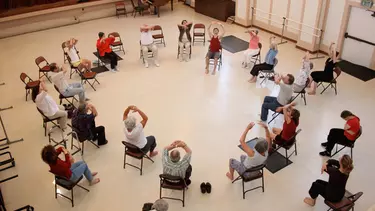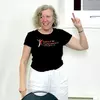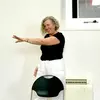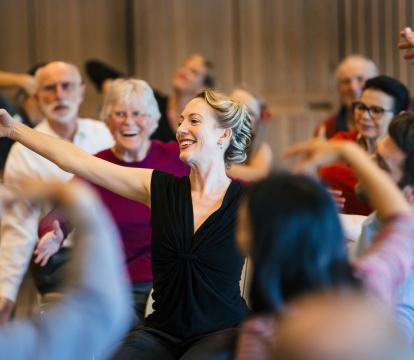Dancing to de-feet Parkinson’s
There are still a lot of unknowns when it comes to Parkinson’s disease. But as research progresses, dance stands out as a form of exercise helping to control symptoms and giving strength to those living with the condition.
It was a regular day of work when Sue Miles felt the first symptoms. It started off with a restless, involuntary tremor in her hands - noticeable in her writing - accompanied by a stiffness in her left leg. Six months later, doctors gathered together all the symptoms and finally put a name to her condition.
Sue was only 39 when diagnosed with Parkinson’s, joining more than 10 million people worldwide living with the disease. Like many others, she had to discover a new way of living.
The causes for this condition haven’t been completely unravelled just yet. Currently, studies around the world are attempting to crack that mystery. But there is one thing that researchers are certain about. Exercise is essential to prevent and control Parkinson’s.
One could then ask: what are the best types of exercise for those living with the disease? The answer depends on who you ask. But Sue would put dance on top of that list.
‘Dance for Parkinson’s’ is a not-for-profit organisation founded in the US by Mark Morris Dance Group and the Brooklyn Parkinson Group. Since 2001, the organisation has been supporting people with the condition and their families to find joy and relief through dance.
Throughout the years, the organisation has expanded its activities beyond the North American borders, partnering with institutions across 25 countries, including Australia.
Dr Erica Rose Jeffrey is the powerhouse behind Dance for Parkinson’s Australia (DPA), and the person responsible for kicking-off its Asia Pacific activities back in 2012.
Erica is a life-long dancer, and defines herself as a ‘dance-activist’. She believes in the power of movement connected to positive social change, and this is the exact fuel for her dance classes.

How did you become involved with Dance for PD®, and what motivated you to bring it to Australia?
I started to teach Dance for Parkinson’s classes based on the Dance for PD® model while living in California in the United States. I came to Australia as a Rotary World Peace Fellow to complete my Masters in International Relations - Peace and Conflict Studies at the University of Queensland. Based on my experiences and interest from Australian Parkinson’s and dance artist communities, I worked with Dance for PD® Director and founding teacher, David Leventhal, to provide the first teacher training workshops in Australia and to build the network of teachers and classes across Australia.
I feel so fortunate to be teaching Dance for Parkinson’s classes as I have the opportunity to see and share in real-life moments of connection and joy between loved ones, partners, family members and friends on a regular basis. There are so many beautiful and inspiring moments as well as the enduring presence of the meaningful communities that have developed around the classes.
Is there scientific evidence of the benefits of dance for people with the condition?
Yes! In addition to the benefits that we as teaching artists witness in classes, there is a growing body of international scientific evidence about the benefits of dance for people living with Parkinson’s as well as for creative ageing. There are over 40 published peer-reviewed research articles focused on dance for people living with Parkinson’s. In Australia studies include research projects through the Queensland Ballet, the University of Queensland and Queensland University of Technology.
What are these benefits?
The impact of dance for people living with Parkinson’s include physical, emotional, social and cognitive benefits. These include improvements in gait and tremor, decreasing rigidity and overall improvements in quality of life. Because dance is a rich multisensory experience involving music, creative expression and social interaction it has benefits beyond basic exercise.

How often should people with the condition dance?
We encourage people to dance as much as works for their particular context. Often classes happen weekly, which might also be supplemented by at-home practice. Through the experience of COVID-19, more classes and resources have been made available online so there is a range of options with both streaming and on-demand resources for people to be able to join in.
Is dance a safe activity for those with Parkinson’s?
Our Dance for Parkinson’s classes are tailored for the Parkinson’s community and include a range of options for safe participation, including seated and supported standing variations. We focus on artistic expression, creativity and social connection and invite everyone to participate in their own way. Teaching artists are experienced in their own practice, complete the Dance for PD® Teacher Training workshop and engage in ongoing professional development.
Based on positive anecdotal evidence from patients and scientific data from multiple research studies regarding the benefits of dance for people living with Parkinson's, many neurologists regularly refer their patients to Dance for Parkinson’s classes.
What sorts of movement can people expect from these classes?
First of all, our classes are fun and creative, including a diverse range of dance styles and music. Movements are influenced by teaching artists’ own dance backgrounds as well as performances or events that are happening in local areas. Some of the themes I have explored recently in different classes include the Australian landscape, the Sleeping Beauty ballet, sea shanties, and motorcycles.
How popular are the classes? What is the participants’ age group?
Once people attend a class they have what is called a ‘high adherence’ in that they keep coming back regularly. For many of our dancers, these classes may be the first time they are trying out a dance class, so it can be a new experience on many levels. The age of participants depends on particular classes and communities. Generally the frequency of diagnosis for people living with Parkinson’s increases over 50 years of age, so many of our participants are mature age dancers. As classes are open to family members, carers and friends, there are always a range of ages in our classes.
How do you think this activity can also benefit the families of people with the condition?
The classes provide a positive quality of life activity for people living with Parkinson’s and this includes their families. We often have spouses attend classes together and in one case I had a participant who brought each of her children and grandchildren to class on a rotating schedule. As the classes are focused on dance and creativity, rather than on Parkinson’s, they can be an opportunity to engage in a fun activity together in an inclusive social environment. Additionally, the benefits of dance for people living with Parkinson’s support increased quality of life and creative ageing.
How did the partnership between DPA and the SOH come about?
The partnership for the Dancing Connections started when the Mark Morris Dance group performed at the Sydney Opera House in 2015. The SOH hosted a Dance for PD® Teacher Training workshop with Dance for Parkinson’s Australia and dance artists from the company co-led the training. This also was our first community class in the beautiful Utzon room. This initial community class led to the Dancing Connections events with opportunities for the Parkinson’s community to connect to performances and events happening at the SOH.


Sue, now 55, has been attending dance classes every week for two years. And it’s paid off, proving to be salve for body and mind. This might just be her best move to tackle the disease yet.
The Sydney Opera House has been engaged in supporting the community through Accessible programming, offering online resources, audio-described and AUSLAN interpreted events, as well as a range of experiences for people with different abilities.
Explore the full schedule of live and digital events here.
